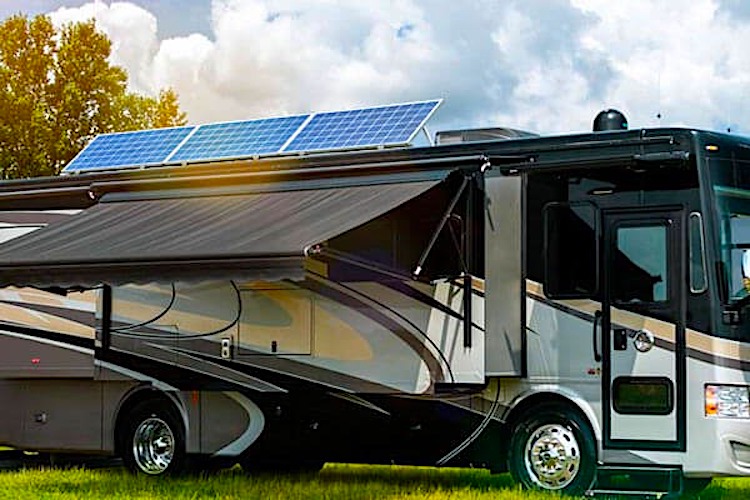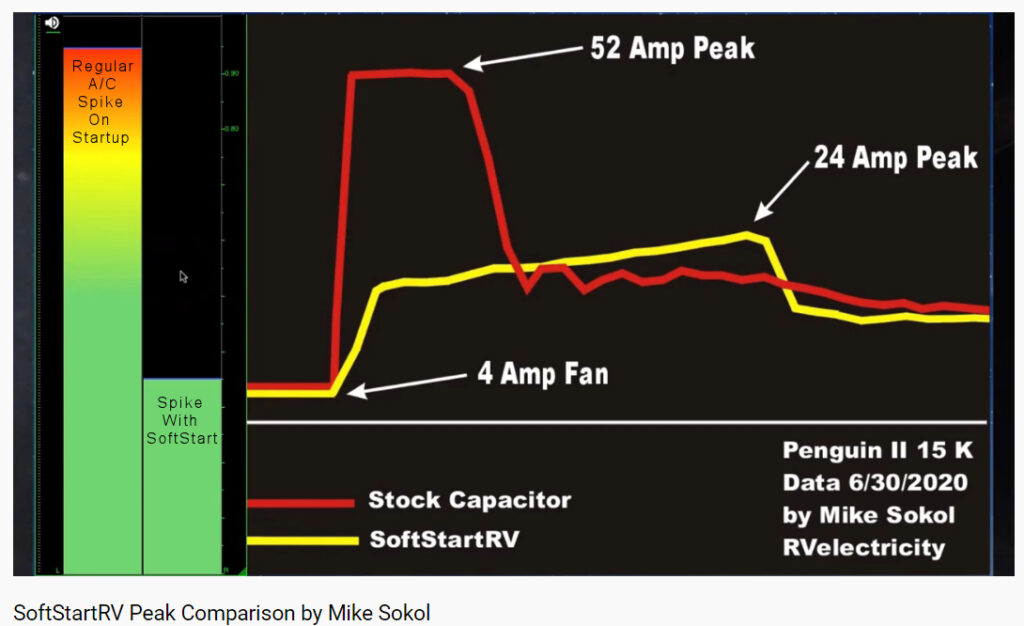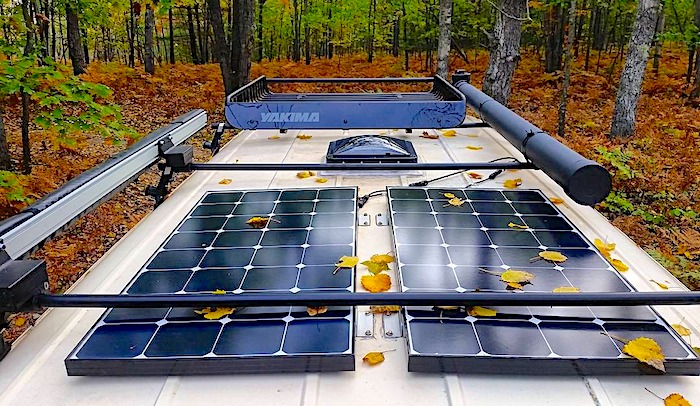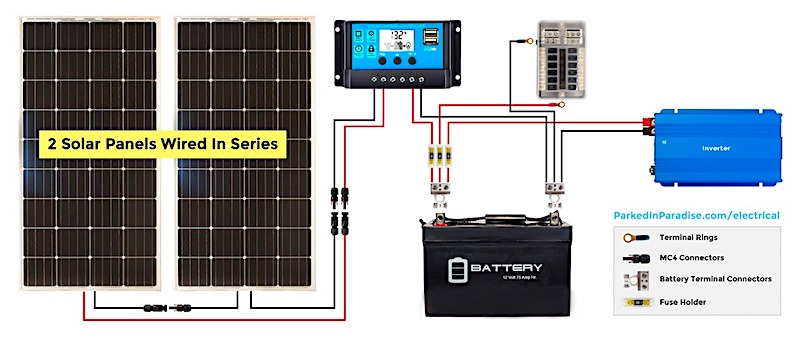Thanks for your support! If you make a purchase using our links in this article, we may make a commission. And, as an Amazon Associate, I earn from qualifying purchases. See the full disclosure here.
If you’re an RV owner, or soon to be, you may be wondering: can you use solar power for RV air conditioners?
The answer, however, is not a cut and dry one depending on your RV and the size of your air-conditioner.
Join us below as we share our surprising answer to this question that so many RVers are curious about.
Can You Use Solar Power For RV Air Conditioners?
Yes, you can use solar power for an RV air conditioner, but there are many different factors to consider before trying. Factors like AC size and energy usage, solar panel capacity, and the size of your battery bank all come into play here.
First things first, depending on the size and energy needs of your RV AC, you may need a very large solar panel and battery bank system to run it.
Next, you will need to do some calculations to determine exactly how long you can run your RV air conditioner on solar power. Even if you can start it up, you may not be able to run it very long unless you have an appropriately sized system.
Using Solar Panels to Power RVs: Does it Really Work?

Solar panels and RVs go together like peanut butter and jam. At least that is how it is in many RVers’ minds and you can pretty much see why.
With the right set-up, solar panels can power your entire RV, motorhome, van, or camper.
That said, some of the appliances in your RV require more energy to run than others. So, the number of appliances and outlets you are powering determine how feasible this question is for you.
The installation process is not a hard one once you decide to go through with it (which we go over with you step by step below). The solar panels are attached to the roof of the RV, wires are run inside to a charge controller and batteries, and your rig is powered by the sun.
There is a bit more to it than that, but it’s genuinely not much more complicated than that.
How Much Solar Power Do RV Air Conditioners REALLY Take?
You will need to install at least 1000 watts worth of solar panels if you expect the system to handle appliances inside the rig such as an RV air-conditioner.
However, solar panels are not exactly known for generating the most reliable amounts of energy at all times, so, the more the merrier. You’ll also need a hefty battery bank to store the power and manage the load.
In general, with two 100-watt panels installed, a small to mid-sized RV can be fully powered by the sun (without air-conditioning). Adding a third or fourth solar panel could make powering an RV air-conditioner a real possibility without disrupting the rest of the rig’s energy flow from the panels.
Again, a 1000 watt system or higher is suggested for even thinking attempting to power an RV air-conditioner. That could be four 250 watt panels, two 500 watt panels, or any other combination you decide. A controller and battery bank will also be necessary, as mentioned above.
It is important to note though that even at 1000 watts, your solar system will only be capable of efficiently running approximately 5000 to slightly under 10000 BTU. For a 15000 to 35000 BTU RV air-conditioner, 1500 watts should do the trick (with the right system).
Hence, the more batteries you have for power storage, and the higher-quality and quantity of panels you have installed, the easier it will be to power your RV air-condition via strictly sunlight.
Also, depending on the type of RV air-conditioner, and the solar system in general, it is still only recommended to run the AC for no more than 4 to 5 hours per day (pretty much during the hottest times only).
Helpful Tips for Running Your RV Air Conditioner on Solar Power
RV air conditioners are arguably one of the most power-demanding appliances in your entire RV.
Although they don’t run all the time, they draw a lot of power – especially when starting up.
When your RV air conditioner compressor kicks on, it can actually draw more than double the power that it needs to run. This factor can make it really difficult to run sustainably on solar power alone.
Luckily, there are devices that can help mitigate the power draw of your RV air conditioner on startup.
If you want to use solar power for RV air conditioner operation, we strongly consider installing an RV air conditioner soft start.
To put it in simple terms, a soft start device puts a throttle on the energy draw of your RV AC when it starts up. This device is helpful for RVers running two ACs on shore power, and is a great benefit for RVers using solar power for RV air conditioners.
Pictured above is a handy graphic showing the benefits of using a soft start for your RV air conditioner. A soft start device can reduce the initial power draw of your RV AC by up to 70%.
How Do I Install Solar Panels on My RV?
Once you’ve come to the conclusion that you’re going to add a solar system to your RV, proper installation is your next course of action. That said, following a few easy steps, you should have your solar panels powering your AC unit, and RV in general, in no time.
Here are five easy to follow steps for installing solar panels on an RV:
Step 1: Determining System Requirements
The first and one of the most crucial steps to installing solar on an RV is properly gauging how much energy will be required from the system to efficiently power things. You can use this handy RV solar power calculator to get a good idea!
If you weren’t concerned about powering an RV air-conditioner, you would only require a few hundred watts of solar panels to keep your batteries topped off with juice. That said, for running a bit more, such as TVs, lights, and small appliances, 500 watts or more is recommendable.
For those interested in powering their RV air-conditioners with solar a bit more power is going to be necessary (1000 to 1500 watts preferably).
Step 2: Choosing RV Solar Power Components (or a kit)
Once you decide how much energy you will be creating with your solar system, it’s time to start picking out the individual pieces that will make it up or purchasing a ready-to-go RV solar kit.
Depending on your budget, and your plans, a practical solar system can be added to an RV for approximately $500 (give or take a couple hundred). That said, solar systems can range well into the thousands of dollars.
Keep in mind that anything less than 1000 to 1500 watts worth of solar panels, and the battery storage to match, will not be enough to power most RV air-conditioners.
Check out this WindyNation 400 Watt Solar Panel Kit + 1500 Watt VertaMax Power Inverter + AGM Battery Bank Off-Grid 12 Volt Battery System. It’s not cheap but it has a good reputation.
Basic RV Solar System Components:
- Solar cells (panels)
- Charge controller
- Wires and connectors
- Battery
Solar Cells (panels)
The solar panels are the solar cells that generate energy from sunlight. Due to being placed on rooftops of RVs, these panels are able to absorb an optimal amount of photons and convert into DC via an inverter or charge controller. A battery, or array of batteries, can then be used to store the energy.
Charge Controllers
The charge controller in your solar system is another essential component. Charge controllers are not used in grid-tie systems.
At any rate, charge controllers are used primarily for charging the battery bank of your solar system. A good charge controller with have features that protect your solar system from overcharging or otherwise shorting out or be damaged.
Note: make sure that you install a negative ground unit when hooking up your solar system’s charge controller. If you use a positive unit and mount it to your RVs grounding plate, your system will be shorted out.
Wires, Connectors, and Fuses
These components are pretty much self-explanatory. Wires allow the individual components of your off-grid solar system to link and work together. Likewise, connectors and fuses additionally allow the system to connect. These components also help protect the integrity of your RV’s solar system.
Skimping out on these components, thinking they are not as important as the actual panels, battery, or charge controller is a rookie mistake. Don’t let it happen to you.
Poor wires, connectors, and cheap fuses will result in a weak and faulty solar system that eventually sometimes works and sometimes doesn’t.
Batteries
Solar batteries are basically the fuel tank for your solar system. The battery determines how much energy you can store, and for how long. Depending on how you arrange and install your solar system you may choose from a wide variety of suitable batteries. You can also tie in more than one battery to your system.
The three main types of solar batteries:
- Lead Acid
- AGM
- Lithium
Note: take care to purchase the most suitable sort of battery for your solar system as recommended by the solar panel/charge controller manufacturer. Anything less may not result in optimal performance for the entire system.
Step 3: Double-Checking Equipment and Installation
Once you choose your equipment or kit, and purchase it, it’s time to inspect and install the new solar system to your RV. Keep it simple, follow the instructions from the manufacturers, and move slow.
Before starting the installation process, be sure to go over all documentation and instructions and check each part/component. This includes mounts, wires, connectors, fuses, panels, invert/charge controller, screws, and more.
Step 4: Finish Install, Triple Check, and Test RV Solar System
Most solar systems come with clear and easy to follow directions and take no time to install. Depending on your RV, experience, and the solar products you intend to install, various tools may are necessary. This includes power drills, screwdrivers, Allen wrenches, and wire cutters to name a few.
That said, once everything is mounted, wired/connected, and ready to go, take a few moments to double and triple check everything before “flipping the switch.” When it comes to something of an electrical nature (let alone costs a decent amount of your hard-earned money), there is no other way.
Final Thoughts About Powering an RV Air Conditioner with Solar Panels
Powering an RV air condition unit of between 10000 and 35000 BTUs is absolutely possible. However, the number of panels needed to power the rest of the RV, let alone keep the AC unit running all day, would be pretty high.
If you think that solar panels are the best way to power your RV’s air conditioner, just remember to keep your usage down. More than four or five hours a day and you won’t have any power left for anything else. This includes the fridge and other essential appliances.
Do you, or do you plan to, use solar panels for powering your RV’s air conditioner? If so, what’s your experience? We’d love for you to share with our audience in the comments section below.
Good luck with powering your RV’s AC unit using solar panels!





